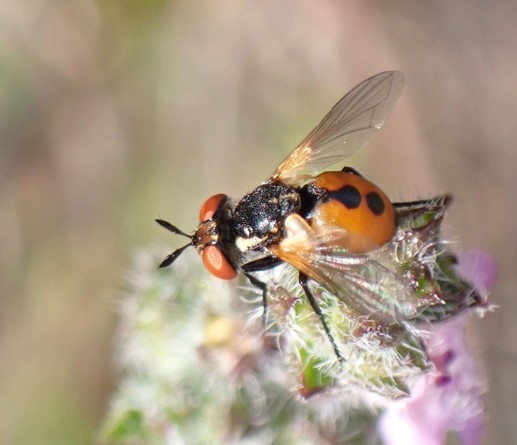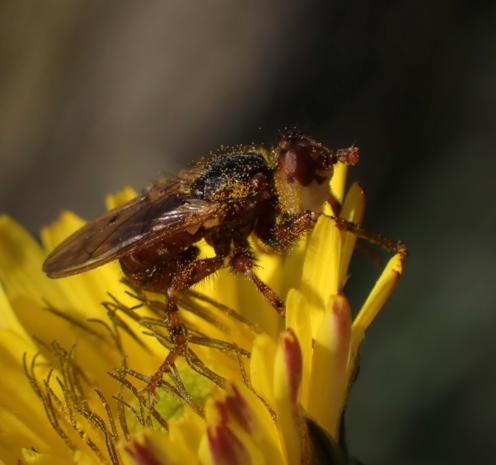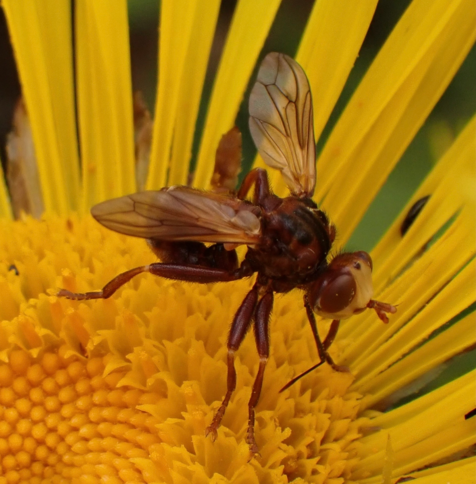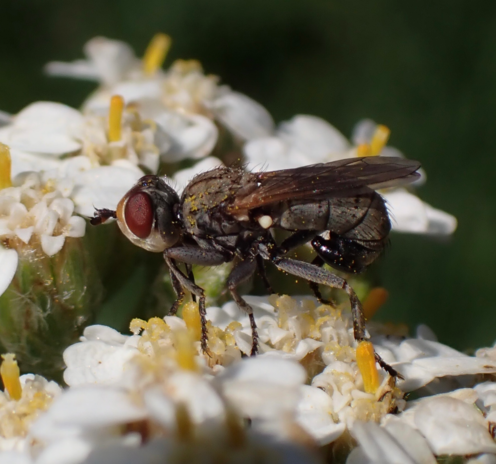Bath Nature · @BathNature
1801 followers · 1041 posts · Server ecoevo.socialA couple of Thick-headed Flies #Conopidae - Waisted Bee-grabber (Physocephala rufipes), and a pair of mating Ferruginous Bee-grabbers (Sicus ferrugineus) - both species are parasites of bumblebees, pouncing on them and injecting eggs inside them.
#Fly #Flies #Diptera #Bees #Parasites #Entomology #Insect #Insects #Wildlife #WildlifePhotography #Nature #NaturePhotography #NatureCommunity
#conopidae #fly #flies #Diptera #bees #parasites #entomology #insect #insects #wildlife #wildlifephotography #nature #naturephotography #naturecommunity
Albert Cardona · @albertcardona
1808 followers · 2727 posts · Server mathstodon.xyzFlies galore, of the parasitoid kind:
Tachinid fly, Gymnostoma rotundanum http://www.inaturalist.org/observations/165099855 . The #Tachinidae lay eggs on the surface of their host—often other insects—with such strong glue that removing the egg would kill the host. Often even drop larvae directly on the hosts.
Thick-headed fly, Physocephala visatta http://www.inaturalist.org/observations/165098840 The #Conopidae are internal parasites of bees and wasps—intercepting them in mid flight, the female’s abdomen has a “can opener” to insert an egg between the abdominal tergites of the host.
Beefly, Lasiopa sp. http://www.inaturalist.org/observations/165105614 The #Bombylidae drop their eggs while in flight near the entrance of solitary bee nests. The larvae crawl in and take over the bee’s resources of nectar and pollen, either starving or directly eating the bee larva.
All the adults happily sip nectar; the larvae, meanwhile, rival parasitoid wasps in their lifestyle and effectiveness.
#crete #diptera #insects #entomology #inaturalist #bombylidae #conopidae #tachinidae
Huxley · @huxley
10 followers · 15 posts · Server ecoevo.social@JENCMARS @CATSELBOW I'VE DOCUMENTED 3 DIFFERENT SPECIES IN MY BROOKLYN GARDEN.HTTPS://WWW.INATURALIST.ORG/OBSERVATIONS?PLACE_ID=ANY&TAXON_ID=61897&USER_ID=XRIS&VERIFIABLE=ANY&VIEW=SPECIES#FLIES #DIPTERA #CONOPIDAE #ECOLOGY #INATURALIST #BROOKLYN #URBANGARDENING #HABITATGARDENING@DARWIN
#Diptera #conopidae #ecology #inaturalist #brooklyn #urbangardening #habitatgardening
Flatbush Gardener 🌈 · @xris
801 followers · 10619 posts · Server ecoevo.social@jencmars @catselbow
I've documented 3 different species in my Brooklyn garden.
https://www.inaturalist.org/observations?place_id=any&taxon_id=61897&user_id=xris&verifiable=any&view=species
#Flies #Diptera #Conopidae #Ecology #iNaturalist #Brooklyn #UrbanGardening #HabitatGardening
@darwin
#flies #Diptera #conopidae #ecology #inaturalist #brooklyn #urbangardening #habitatgardening
Albert Cardona · @albertcardona
1697 followers · 1934 posts · Server mathstodon.xyzSurprise, surprise. Looking for native bees instead I found what looks like one of their parasites: a conopid fly. Their larvae are endoparasites of bumble bees of the genus Bombus, and pupate and overwinter in their victims. So instead of a beautiful bumblebee we get this weirdo ugly fly.
Sicus ferrugineus (tentative ID) https://www.inaturalist.org/observations/153457725
#conopidae #diptera #inaturalist #insects #entomology
Albert Cardona · @albertcardona
1157 followers · 316 posts · Server mathstodon.xyz@entospace Ah yes indeed, Sicus ferrugineus! This graceless-looking conopid parasitoid fly is rather abundant here in Cambridge, and they are parasites of bumblebees.
Left: https://www.inaturalist.org/observations/124556281
Right: https://www.inaturalist.org/observations/85790161
#conopidae #entomology #insects #diptera #iNaturalist #bumblebees
#bumblebees #inaturalist #diptera #insects #entomology #conopidae
Albert Cardona · @albertcardona
1153 followers · 298 posts · Server mathstodon.xyzNot only the wasp clade developed parasitoid species. Flies did too, particularly in the Conopidae family https://en.wikipedia.org/wiki/Conopidae –easy to recognize by the curved tip of their abdomens.
Some conopids sneak attack bees and wasps in mid air, inserting an egg in between their dorsal abdominal tergites (the surface hardened plates of each segment).
Zodion sp. possibly male (lacks the can opener-like ending of a female) from the #Pyrenees https://www.inaturalist.org/observations/127056906
#conopidae #diptera #inaturalist #pyrenees





